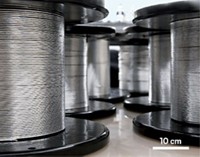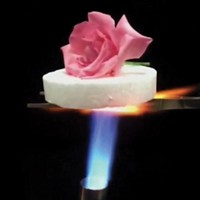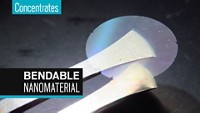Advertisement
Grab your lab coat. Let's get started
Welcome!
Welcome!
Create an account below to get 6 C&EN articles per month, receive newsletters and more - all free.
It seems this is your first time logging in online. Please enter the following information to continue.
As an ACS member you automatically get access to this site. All we need is few more details to create your reading experience.
Not you? Sign in with a different account.
Not you? Sign in with a different account.
ERROR 1
ERROR 1
ERROR 2
ERROR 2
ERROR 2
ERROR 2
ERROR 2
Password and Confirm password must match.
If you have an ACS member number, please enter it here so we can link this account to your membership. (optional)
ERROR 2
ACS values your privacy. By submitting your information, you are gaining access to C&EN and subscribing to our weekly newsletter. We use the information you provide to make your reading experience better, and we will never sell your data to third party members.
Materials
Mica meets mother-of-pearl to make ultratough electrically insulating paper
Nacre-inspired nanostructure yields high-performing material for demanding electrical applications
by XiaoZhi Lim, special to C&EN
January 29, 2020
| A version of this story appeared in
Volume 98, Issue 5

Electrical components in vehicles and power stations continue to shrink while becoming more powerful, so engineers need materials that pack more performance in a smaller space. For example, the electrical insulators within high-speed train motors must be flexible enough to wrap around rotors but also strong and resistant to strain, heat, and high voltage.
For insulation, today’s power generators, transformers, and capacitors typically use mica paper—thin sheets of the mineral mica in its pure form or laminated with polymers. Yet no single material currently embodies all the desired properties, says Jianfeng Wang of Hunan University. Pure mica can withstand very high voltages and temperatures but is brittle and weak. Strengthening pure mica paper by incorporating other materials causes its electrical and heat resistance properties to suffer. Wang and his team turned instead to natural nacre—also called mother of pearl, the exceptionally tough material that lines many mollusk shells—as inspiration for next-generation mica paper that could be strong while retaining its insulating properties (ACS Nano 2020, DOI: 10.1021/acsnano.9b07192).
Wang has been studying how to mimic nacre since 2012, when he was still a PhD student. Nacre’s nanostructure protects seashells from cracking: layers of hard calcium carbonate platelets are embedded in a three-dimensional architecture of protein nanofibers.

Previously Wang’s team had developed a way to make a nacre-mimicking material with platelets made from graphene instead of calcium carbonate (Adv. Funct. Mater. 2019, DOI: 10.1002/adfm.201903876). They used the same process this time to impart nacre’s nanostructure to mica nanopaper.
In place of the protein nanofibers in nacre, the team prepared nanofibers of Kevlar 29 by treating it with a strong base. They then made a colloidal solution by mixing the nanofibers with synthetic mica nanoplatelets dispersed in dimethyl sulfoxide (DMSO) solvent. The team poured the resulting viscous, red solution into a petri dish, covered it with a microporous membrane, and immersed it in water. Over 24 hours, water gradually displaced the DMSO, creating a pale yellow hydrogel. After drying the hydrogel at room temperature, the team had a piece of mica nanopaper about 25 µm thick.
The ultratough nanopaper could absorb 109 MJ/m3 of energy before cracking. Compared to Nomex 818, a mica-and-Kevlar-based electrical insulating tape already used for high-voltage applications, it could withstand a maximum voltage over five times as high, was almost five times as strong, and had slightly better heat resistance. While Nomex 818 could stretch just slightly to 1.02 times its length without breaking, the new material could stretch to 1.8 times its length before failure.
“The properties are quite exciting and off the charts to some degree,” says Nicholas Kotov, a materials scientist at the University of Michigan. “These are very significant parameters for numerous applications.”
The researchers cobbled various equipment together to produce the nanopaper continuously, churning out a 25 mm wide tape at 24 m/h. They are now trying to reproduce the material with nanoplatelets of natural mica, which is much cheaper than synthetic mica but requires processing to achieve the necessary uniformity and purity before it can be used, Wang says. Potential commerical uses include high-speed trains, aerospace, and miniature high-powered electrical equipment, he adds.
CORRECTION
This story was updated on Feb. 3, 2020, to correct the name of the study author quoted in the article. It is Jianfeng Wang, not Jianwei Wang.





Join the conversation
Contact the reporter
Submit a Letter to the Editor for publication
Engage with us on Twitter